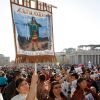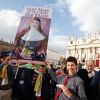Pilgrims flock to Rome to celebrate their new saints
VATICAN CITY (CNS) -- Wearing Native American beads and feathers, Hawaiian leis, classic Filipino shirts, or German dirndls, Catholics from around the globe gathered in St. Peter's Square to celebrate the recognition of seven new saints.
One of the pilgrims who came to celebrate the canonization of St. Kateri Tekakawita Oct. 21 was Blessed Sacrament Father Dana Pelotte, twin brother of the late Bishop Donald E. Pelotte of Gallup, N.M., the first American Indian bishop of the United States.
"I think the canonization will have a tremendous spiritual effect on the native peoples -- I really do. Being a native person has so much spiritual beauty," and the canonization of Kateri, the first indigenous saint of North America, will strengthen that, said the priest, whose father was of Abenaki descent.
Attending a reception sponsored by the U.S. Embassy to the Holy See in the Vatican Museums' garden Oct. 19, Father Pelotte was constantly approached by American Indian pilgrims who told him of their love for his brother and how pleased he would be by the canonization. "I know he's here in spirit with us today," Father Pelotte told each one of them.
Archbishop Charles J. Chaput of Philadelphia, a member of the Prairie Band Potawatomi Tribe, told Catholic News Service that he and his fellow Native American Catholics have been praying for St. Kateri's canonization for a very long time.
The saint was born to an Algonquin Christian mother and a Mohawk father, who died when she was young. She resisted strong pressure from the Mohawks to abandon her faith, so she could be considered a model for those facing religious persecution, the archbishop said.
St. Kateri, who died in 1680 at the age of 24, also is a model for the new evangelization, Archbishop Chaput said.
"She was a young, vibrant member of her community, but she was different from the rest of them because of her unique personal relationship with Jesus Christ, which is what sanctity is generally about -- it's about taking Christ seriously in a personal way, in a way that goes beyond where most of us go."
Clarence "Boogie" Kahilihwa and Gloria Marks were two of nine patient-residents who came to the canonization from Kalaupapa, Hawaii, where the new St. Marianne Cope ministered among people with Hansen's disease, which is commonly called leprosy.
Kahilihwa said St. Marianne left as her legacy "how she felt toward humanity," and that her message is "never underestimate" the value of person, no matter what their sickness is; "and don't be afraid to challenge the unchallenged and down low."
"I could have gone out a long time ago, but I chose to stay" to help care for older members of the community, he said.
Kahilihwa also said part of St. Marianne's legacy is the affirmation that there is no such thing as "a leper," because leprosy "is a disease, not a person."
Marks, like Kahilihwa, came to Rome in 2009 for the canonization of St. Damien de Veuster of Molokai, who founded the Kalaupapa community and who later was among those cared for by St. Marianne.
"I'm really proud because (there are) two of them from the same county, the smallest county in Hawaii," she said.
"Those two put Hawaii on the map. So it's very, very important to us."
U.S. citizens and residents also turned out in large numbers for the canonization of St. Pedro Calungsod, a Philippine teenager and catechist who was martyred in 1672 in Guam, which is a territory of the United States.
At a thanksgiving Mass Oct. 22 at the Altar of the Chair in St. Peter's Basilica, Archbishop Anthony Sablan Apuron of Agana, Guam, called St. Pedro a wonderful model for Catholic youth. "May it never be said that we who had the privilege of witnessing the canonization of San Pedro did not make it heaven!" he told the pilgrims, who included many young people.
The archbishop, who concelebrated the Mass with retired Cardinal Ricardo Vidal of Cebu, Philippines, composed a song in honor of St. Pedro 12 years ago on the occasion of the youth's beatification. Archbishop Apuron sang it during the homily, demonstrating that he, too, saw the martyred saint as a model.
"San Pedro proclaimed his faith using human means to attract the Chamorros (native people of Guam) through the use of visual aids, putting the doctrines and teachings to music so as to enable the natives to learn the doctrines of the church more easily," Archbishop Apuron said.
Discalced Augustinian Father Alex Remolino, a Philippine priest working in Rome, said that in addition to being a model for youth, "St. Pedro is a patron saint of our emigrants."
St. Pedro left the Philippines to work with the Jesuits in Guam, and he carried his faith with him, just as many Philippine emigrants do today when they go abroad to study or work, he said.
"Faith is part of our DNA," Father Remolino said. "Wherever we go, we bring the Gospel. It's not just part of our culture, but part of our character."
- - -
Contributing to this story were Carol Glatz and Francis X. Rocca.
Pope proclaims seven new saints, including St. Kateri, St. Marianne
VATICAN CITY (CNS) -- Proclaiming seven new saints -- including St. Kateri Tekakwitha and St. Marianne Cope from North America -- Pope Benedict XVI said they are examples to the world of total dedication to Christ and tireless service to others.
In a revised canonization rite Oct. 21, the pope prayed for guidance that the church would not "err in a matter of such importance" as he used his authority to state that the seven are with God in heaven and can intercede for people on earth.
An estimated 80,000 pilgrims from the United States, Canada, the Philippines, Italy, Spain, Germany and Madagascar filled St. Peter's Square for the canonization of the holy women and men who ministered among their people.
The pilgrims applauded the proclamation of the new saints, who included: Kateri, an American Indian who was born in the United States and died in Canada in 1680; Mother Marianne, a Sister of St. Joseph who traveled from Syracuse, N.Y., to Hawaii to care for people with Hansen's disease and died in Molokai in 1918; and Pedro Calungsod, a teenaged Philippine catechist who was martyred in Guam in 1672.
The other new saints are: French Jesuit Father Jacques Berthieu, martyred in Madagascar in 1896; Italian Father Giovanni Battista Piamarta, founder of religious orders, who died in 1913; Sister Carmen Salles Barangueras, founder of a Spanish religious order, who died in 1911; and Anna Schaffer, a lay German woman, who died in 1925.
In his homily at Mass following the canonization, Pope Benedict prayed that the example of the new saints would "speak today to the whole church" and that their intercession would strengthen the church in its mission to proclaim the Gospel to the world.
The pope also spoke about each new saint individually, giving a short biographical outline and highlighting a special characteristic of each for Catholics today.
Pope Benedict called St. Kateri the "protectress of Canada and the first Native American saint," and he entrusted to her "the renewal of the faith in the First Nations and in all of North America."
The daughter of a Mohawk father and Algonquin Christian mother, St. Kateri was "faithful to the traditions of her people," but also faithful to the Christianity she embraced at age 20. "May her example help us to live where we are, loving Jesus without denying who we are," the pope said.
Archbishop Charles J. Chaput of Philadelphia, who is of American Indian descent, told Catholic News Service, "I think many young people today are embarrassed about embracing the Catholic faith because they live in a secular culture that's hostile toward religious experience."
St. Kateri also "grew up in a place where there was great hostility toward Christianity," Archbishop Chaput said, but she resisted all efforts to turn her away from her faith, "so in some ways she would be a model of fidelity in the face of persecution on religious freedom grounds."
Archbishop Gerald Cyprien Lacroix of Quebec told CNS that the canonization of the first aboriginal of North America is "huge for us." St. Kateri, he said, is an excellent model for young people of "living a simple life, faithful to the Lord in the midst of hostility."
St. Kateri's life and canonization show that "saints don't have to do extraordinary things, they just have to love," Archbishop Lacroix said.
Francine Merasty, 32, a Cree who lives in Pelican Narrows, Sask., said, "Kateri inspires me because she's an aboriginal woman. According to sociologists, aboriginal women are at the lowest (social) strata, and for the church to raise up to the communion of saints an aboriginal woman is so awesome and wonderful."
Jake Finkbonner, the 12-year-old boy from Washington state whose healing was accepted as the miracle needed for St. Kateri's canonization, received Communion from the pope during the Mass. Jake's parents and two little sisters did as well.
Speaking about St. Marianne of Molokai in his homily, Pope Benedict said that a time when very little could be done to treat people with Hansen's disease, commonly called leprosy, "Marianne Cope showed the highest love, courage and enthusiasm."
"She is a shining example of the tradition of Catholic nursing sisters and of the spirit of her beloved St. Francis," the pope said.
Leading a group of Hawaiian pilgrims, including nine patient-residents from Kalaupapa, where St. Marianne ministered, Honolulu Bishop Larry Silva said St. Marianne is "an inspiration for those who care for those most in need, which is what all Christians are called to do. Now, with universal veneration, she can inspire people around the world."
With thousands of Philippine pilgrims in St. Peter's Square, Pope Benedict praised St. Pedro, a catechist who accompanied Jesuit priests to the Mariana Islands in 1668. Despite hostility from some of the natives, he "displayed deep faith and charity and continued to catechize his many converts, giving witness to Christ by a life of purity and dedication to the Gospel."
The pope prayed that "the example and courageous witness" of St. Pedro would "inspire the dear people of the Philippines to announce the kingdom bravely and to win souls for God."
Pope Benedict also cited St. Anna Schaffer as a model for a very modern concern.St. Anna was working as a maid to earn the money for the dowry needed to enter a convent when an accident occurred and she "received incurable burns" which kept her bedridden the rest of her life, the pope said. In time, she came to see her pain and suffering as a way to unite herself with Christ through prayer, he said.
"May her apostolate of prayer and suffering, of sacrifice and expiation, be a shining example for believers in her homeland, and may her intercession strengthen the Christian hospice movement in its beneficial activity," the pope said.
- - -
Contributing to this story was Francis X. Rocca.
- - -
[issuu width=420 height=258 printButtonEnabled=false backgroundColor=%23222222 documentId=121018202102-3c059b87113a4d82ba02989f22b40f1a name=kateri username=catholicregister tag=special unit=px v=2]
You can enjoy the features below about St. Kateri Tekakwitha on CatholicRegister.org.
VATICAN CITY - In a continuing effort to preserve the integrity of the Mass and highlight the meaning of a canonization, when Pope Benedict XVI declares seven new saints Oct. 21, the ceremony will look different than it has in the past.
Msgr. Guido Marini, master of papal liturgical ceremonies, said the change will mark another step in Pope Benedict's efforts to remove from the papal Mass elements that are not strictly part of the liturgy, in accordance with the teaching of the Second Vatican Council.
Earlier, the Pope stopped giving new cardinals their rings during Mass; and in June he started the practice of giving new archbishops a pallium — a woolen band around their necks — before the entrance antiphon of the Mass.
In a similar way, beginning Oct. 21, the canonization rite will take place before Mass begins.
"Canonization is basically a canonical act" through which the Pope exercises his ministry to teach and to legislate, Marini told L'Osservatore Romano, the Vatican newspaper.
"In effect, a canonization is a definitive sentence through which the supreme pontiff decrees that a servant of God, already listed among the blessed, is to be inscribed in the catalogue of saints and venerated in the universal church," the monsignor said.
"The authority exercised by the Pope in a canonization sentence will now be even more visible through the use of certain ritual elements," particularly through the Pope's triple invocation of God's help in making such an important decision, he said.
Marini said the distinction between the canonization rite and the celebration of the Mass is meant to respond to the Second Vatican Council's call for the "splendour of the noble simplicity" of the Mass to shine forth.
The seven women and men who will be proclaimed saints with the new ceremony are:
-- Blessed Kateri Tekakwitha, a native American who was born in upstate New York and died in Canada in 1680 at the age of 24.
-- Blessed Marianne Cope of Molokai, who led a group of sisters from New York to the Hawaiian Islands in 1883 to establish a system of nursing care for leprosy patients.
-- Blessed Peter Calungsod, a lay catechist from the Philippines who was martyred April 2, 1672, in Guam.
-- Blessed Jacques Berthieu, a Jesuit who was born near Polminhac, France, and was martyred June 8, 1896, in Ambiatibe, Madagascar.
-- Blessed Giovanni Battista Piamarta, an Italian priest and founder of the Congregation of the Holy Family of Nazareth for men and the Humble Servants of the Lord for women. He died in 1913.
-- Blessed Carmen Salles Barangueras, the Spanish founder of the Sisters of the Immaculate Conception. She died in 1911.
-- Blessed Anna Schaffer, a lay German woman who wanted to be a missionary, but could not because of a succession of physical accidents and diseases. She died in 1925.
VATICAN CITY - Pope Benedict XVI has approved the heroic virtues of U.S. Archbishop Fulton J. Sheen, the Vatican announced June 28, clearing the way for the advancement of his sainthood cause.
Among the others honored in decrees announced the same day were first prelate of Opus Dei, the Canadian and Irish-American founders of two orders of religious women, a priest murdered by the Sicilian Mafia, and 154 martyrs killed during the Spanish Civil War.
Youth can turn to patron saints for help
Praying to patron saints can be particularly helpful to young people of faith, guiding them through difficult situations, said Fr. Francois Mifsud, chaplain at Toronto’s University of St. Michael’s College.
Patron saints are offered to Christians as role models, associated with issues that matter to individuals, said Mifsud.
“When you read the Gospel, some people say it’s too hard, it’s too much for me,” Mifsud said. “(Patron saints show that) for young people… being a Christian is possible, even though it is challenging.”
Praying to the saints during tough times
It’s a typical experience for students. As the end of the semester approaches, class assignments pile up. This leaves students, especially university and college students, feeling overwhelmed and lost.
Personally, I had been feeling the pressure of a fourth-year course load. With bi-weekly quizzes, four assignments and a thesis due, there were many times I felt trapped — like I could not get out from under the mountain of homework. But I persevered and, this time, I had something in my arsenal to use: prayer.







